OR/13/004 Summary of experimental results
| Rochelle, C A, Purser, G, Milodowski, A E, Noy, D J, Wagner, D, Butcher, A, and Harrington, J F. 2013. CO2 migration and reaction in cementitious repositories: A summary of work conducted as part of the FORGE project. British Geological Survey Internal Report, OR/13/004. |
Static batch experiments
A detailed description of these experiments is given in Rochelle and Purser (2010)[1] and Rochelle et al., (2014)[2], and only a summary is presented here. The aim of these experiments was to investigate fluid chemical, mineralogical, and textural changes upon diffusion-controlled CO2-cement reaction. The batch equipment used consisted of 316 stainless steel pressure vessels with wetted parts lined with PTFE (polytetrafluoroethene) ‘cups’, high pressure tubing was made of either 316 stainless steel or titanium, and O-ring seals were made of Viton®. The large blocks of cured NRVB were sub-cored to produce samples of 25 mm diameter and of 50 mm long, and one of these cores was placed into each vessel, usually by attaching it to the fluid sample tube (Figure 2). This tube remained in place whether or not the experiment contained an aqueous phase or just free-phase CO2. Several experiments were run at the same time, and were often connected to the same pressure line to maintain uniform conditions between them (Figure 3). Temperature control was achieved through the use of either a LMS thermostatically-controlled incubator for experiments at 20°C, or a Gallenkamp Plus2 oven for experiments at 40°C (both accurate to better than ± 0.5°C).
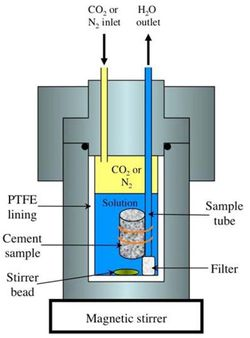
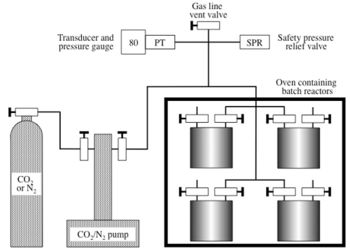
Where used, a quantity (approximately 230g) of cement porewater was placed into the PTFE liner of the vessel, together with a small magnetic stirrer bead to ensure good mixing of the fluids. The total volume of the solid and aqueous samples filled about 70% of each vessel. For experiments involving both porewater and cement, the fluid:solid mass ratio was about 6:1. No porewater was added to the experiments reacting cement with dry gases. Migration of either free-phase or dissolved CO2 into the cement was by diffusional processes.
The CO2 and N2 were supplied to the reactors from ISCO 500D syringe pumps running in ‘constant pressure’ mode. The computerised controller allowed the pressure to be maintained to within 0.1 bar (0.01 MPa). Pressure connections were placed at the top of the vessels so that aqueous fluids (denser than high-pressure N2 or CO2) could not move out of, or between, the vessels. Vessels pressurised with CO2 represented the ‘reactive cases’ and those pressurised with N2 the ‘non-reactive cases’. This allows discrimination between reactions purely due to CO2, and artefacts that might possibly be introduced by the nature/arrangement of the experiments.
Sampling of the aqueous phase at the end of the experiments was carried out via the titanium dip tube (with a 20 µm pore size polypropylene filter fitted to a PEEK™ (polyetheretherketone) mount at the end), which ran to the base of the PTFE liner. Fluid samples were extracted whilst it was still under run conditions, pressure being maintained through the injection of extra CO2 into the headspace of the vessel. As much of the aqueous phase as possible was removed during this process to minimise precipitation of misleading carbonate minerals on depressurisation. The reacted cement sample was extracted after the vessel had been carefully depressurised.
On opening the pressure vessels most samples were found to be intact, with the very few breakages possibly being a consequence of over-rapid depressurisation. It was also immediately apparent that the cement had changed appearance in the presence of CO2, having gone from a mid-grey to a light brown (Figure 4). Cement in contact with N2 showed little or no colour change. This colour change involving CO2 is thought to be due to reaction of calcium ferrite minerals and liberation of the iron oxide/oxyhydroxide to give a ‘rusty’ colour. A similar colour change has been noted for borehole cements exposed to CO2 (Carey et al., 2007[3]).

Prior to the start of the experiments accurate measurements were made of the diameter and length of each cement sample. This process was repeated at the end of the experiments, after the core samples had any surface moisture carefully removed, in order to ascertain if reaction with CO2 had caused any swelling or shrinkage of the cement. No changes in overall sample size were found.
Cement weight changes
Each sample of reacted cement was carefully weighed at the end of each test and compared with their initial weights (Table 1). Several observations were made:

- For tests with dry N2 gas (non-carbonation experiments), all the cement samples lost weight. This seems to have been more pronounced with increasing pressure, temperature and especially timescale. The changes appear to be related to simple dehydration of the cement samples in the dry N2 gas.
- For tests with alkaline waters pressurised with N2 gas (non-carbonation experiments), there is more variation in sample weights. Generally speaking, most samples remained roughly the same weight (within ± 1%). There are 3 exceptions to this:
- The sample reacted at 20°C and 80 bar for 40 days (+2.06%). This weight increase is not typical of similar samples, and was unexpected. It is possible that it may be a consequence of a slightly under-saturated sample at the start of the test, and which took up a little extra water when it saturated during the 40 days of the test.
- The two samples reacted for a year at 80 bar (+3.37% and +2.21%). These weight increases are thought to represent slow and continuous hydration of previously unreacted cement ‘clinker’ phases present within the cement during the extended duration of these longer tests.
- All the tests involving CO2 (i.e. carbonation experiments) gave cement weight increases (except for the one test where the sample broke up), and these were over and above the weight changes observed in the N2-pressurised experiments. This is interpreted as carbonation of the cement minerals such as portlandite and CSH gels, with the weight gain being associated with incorporation of the CO2 into secondary phases.
- Reaction with CO2 resulted in weight increases that were more pronounced with increasing timescale, and especially increasing pressure and temperature. The latter two parameters probably increasing the degree of reaction through more CO2 being present in the reactors, and increased reaction kinetics.
- The largest weight increases were found in tests with just dry CO2 (weight increases of approximately 8%). In terms of molar quantities, the carbonation reaction produces at least as much water as amounts of CO2 consumed (equations [1] and [2]). A dry CO2 atmosphere would have helped remove this water from the cement sample, facilitating access of more CO2 to continue the reaction (see Reardon et al., 1989[4]).
- There are broadly similar weight gains for samples reacted with dry supercritical CO2 for 40 days and for 1 year. This suggests that the vast majority of the cement carbonation was completed in the first few weeks of reaction.
- Given that the cement samples did not change size appreciably during carbonation, but did change weight, then their average density must have increased.
Mineralogical changes
Most cement samples showed broadly similar changes in mineralogy on carbonation. That said, macroscopic differences appear to be at least partially related to the state of the CO2 in the experiment. For example, free phase CO2 gave more pervasive alteration than dissolved CO2, which is possibly linked to ease of transport into the sample (e.g. Reardon et al., 1989[4]). All cement cores, including those from the N2 control experiments, showed some minor carbonation on the outside of them (typically 50–100 µm thick), including cores not deliberately exposed to high pressure CO2. These minor carbonation skins are most likely an artefact of sample handling (e.g. during cutting and exposure to air). They would have formed very rapidly, and prior to the experiments. This CaCO3 coating is very thin compared to the much thicker experimentally-induced carbonation rinds.
Most cement samples displayed evidence for four main zones:
| Zone 1: |
A core zone having only very minor carbonation. |
| Zone 2: | An intermediate zone of partial carbonation. |
| Zone 3: | An outer zone of complete carbonation. |
| Zone 4: | The outermost parts of the sample showing dissolution of initially-formed carbonate minerals. |
In terms of general reactivity, all 3 phases of CO2 showed very similar reaction mechanisms with the cement. Key reactions were the conversion of Ca(OH)2 (portlandite) to a secondary carbonate such as calcite, the conversion of CSH phases such as tobermorite to a secondary carbonate and silica gel, and the conversion of calcium ferrites and calcium aluminates to calcium carbonate and iron oxides/hydroxides and aluminium oxides.

All experiments showed evidence for reaction fronts, and right at the leading edge of these there was commonly a very high porosity zone developed (due to dissolution). All experiments also showed a characteristic outer carbonated zone having an anastomising ‘3D chickenwire’ meshwork of interconnected microfractures (typically on a 10s–100s µm scale). Petrography shows these microfractures were initiated at the reaction front as shrinkage cracks, but were subsequently extensively infilled by secondary calcium carbonate. However, predictive modelling (Purser et al., 2013[5]; see Section 2.3) indicates that the complex interplay between mineral reactions, reaction rates, and back diffusion of calcium ions may theoretically result in repeating narrow fronts of CaCO3 precipitation without microfracturing. In some samples, larger shrinkage cracks up to several mm long were observed in the partly-carbonated zone — some oriented parallel to the carbonation front, and some perpendicular to it. The shrinkage cracks subsequently fill with secondary carbonate. The ultimate product after carbonation was a matrix filled with a meshwork of CaCO3, finely nano- to micro-crystalline CaCO3 and an amorphous Si-rich gel phase and Al-rich material.
The mineralogy of the CaCO3 showed spatial (and possibly temporal) variation. Close to the main reaction front (i.e. where it was first precipitated) it occurred mainly as aragonite and vaterite. However, calcite was increasingly dominant with distance from the reaction front (i.e. where the sample had been carbonated for longer times). This demonstrates another potential complexity of cement carbonation that could be included within numerical models of cement carbonation — even though it remains unclear whether these observations reflect a slow conversion of less stable aragonite or vaterite to more stable calcite over time, or secondary phase control by differences in the local chemical environment.
In terms of uncertainties, the intermediate zone of partial carbonation was very variable in width, ranging from µm to several mm wide. The reason for this variability is not clear. A second area of uncertainty is cement matrix/fabric heterogeneity. For example, a few of the cement samples displayed a strongly grain-size differentiated layered fabric, which was on a similar length scale to the samples used. This appears to be artefact of cement casting, producing coarser and finer layers, with hydro-dynamic segregation of bands of limestone-rich grains and coarser cement clinker. The coarser layers were associated with concentrations of limestone aggregate and coarsely-crystalline Ca(OH)2 cement filling the coarser pore space, whereas the finer laminations were dominated by CSH. CO2 preferentially altered the Ca(OH)2 bands, resulting in uneven alteration and a ‘stripy’ appearance of some reacted cores (Figure 5). However, this did not change the nature of secondary phases produced. Whilst unwanted in these experiments, such heterogeneity has the potential to form within actual repository cement, though the use of additives to inhibit dewatering or grain segregation would help prevent its formation.
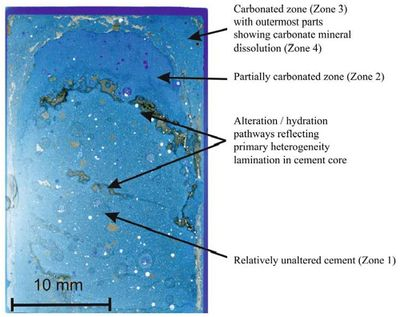
Fluid chemical changes
Chemical changes in aqueous fluids in contact with NRVB cement were determined for most of the static batch experiments and only a subset are shown here (see Rochelle et al., 2014[2] for the full dataset). Prior to describing some of the more noteworthy results, it is important to note that most, if not all, of the experiments had not reached full chemical equilibrium. For example, whilst the outer parts of the cement samples may have been in equilibrium with the surrounding fluids, the central parts of the cement samples were still undergoing reaction. Thus, some dissolved species may have attained steady-state concentrations and have been in equilibrium with stable secondary phases, whilst others were still increasing in concentration. Reaction kinetics and the rate of transport of dissolved species through the cement are thus important considerations in assessing overall cement reactivity. Running experiments for different timescales provides some information as to whether steady-state concentrations had been achieved, with the 12-month long experiments being closest to full equilibration in this study. The maximum duration of the latter was constrained by the duration of the FORGE project.
Comparison of data from experiments of the same duration provides information on the relative changes in fluid chemistry under different conditions.
In the absence of CO2, the pH of solutions in contact with the cement attained values of 12–13 expected for cement-equilibrated waters. However, the pH of the solutions showed a marked decrease on the addition of CO2 (Figure 6). This observation mirrors those from previous studies where CO2 was reacted with samples of cement used to seal the gaps between steel borehole linings and the surrounding rocks (Rochelle et al., 2004[6], 2006[7], 2007[8]). Note that in-situ pH would have been lower than those measured on cooled and depressurised samples. This applies in particular to the CO2-rich waters, which underwent extensive degassing of CO2 on sampling.

As the CO2 was present in excess, it would have provided the dominant control of pH. This can be represented by a series of reactions; first CO2 dissolution, then reaction of CO2 with water, and finally neutralisation of hydroxyl ions:

Subsequently the rate of this reaction would have been dictated by the rate of production of OH- (or H+ consumption) by the sample of cement. A consequence of these reactions is an increase in concentration of dissolved bicarbonate. This illustrates the potential for CO2 to impact the high pH buffering capacity of the cement, and also to increase the concentration of potentially complexing ions in solution.
The two most important phases in cement (portlandite and CSH phases) are both Ca-rich, and led to a significant concentration of Ca in solution (Figure 7). The trends in dissolved Ca are more complex than for pH, as Ca solubility is a function of temperature, fluid composition and CO2 concentration. For example, in the absence of CO2 warmer conditions led to increases in Ca concentration for the ‘young’ porefluids, but lower concentrations for the ‘evolved’ porefluids.
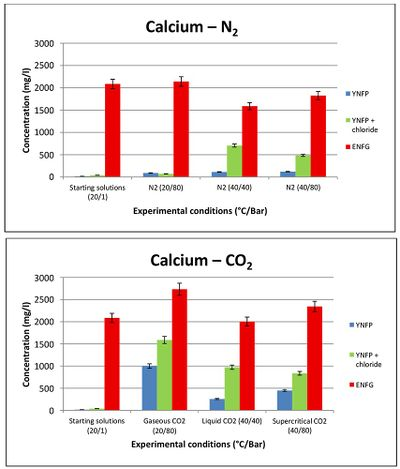
What is clearer however, are the increases in dissolved Ca concentrations in the presence of CO2, and this reflects dissolution of phases within the cement. In the presence of CO2, the phase controlling Ca solubility was most likely calcite, rather than portlandite or CSH phases as in the CO2-free (nitrogen-pressurised) experiments.
Further evidence for dissolution of cement components can be seen in the silica concentration data (Figure 8). These are mostly much higher in experiments containing CO2. The lack of data in Figure 8 for the nitrogen-pressurised experiments reflects concentrations below the detection limits of the analytical technique used, and the mutual exclusivity of dissolved Ca and silica can be explained by equilibration with a CSH phase. The presence of significant Ca and silica in the CO2 experiments also suggests that the solution is no longer equilibrated by CSH phases — the outer parts of the cement having reacted. The source of silica in the CO2 experiments would have been dissolution of CSH phases. The broad consistency of the concentration of dissolved silica at 40°C suggests equilibrium with a common secondary Si phase, which in this case is likely to be silica gel formed through the carbonation of CSH (see reaction [2]).
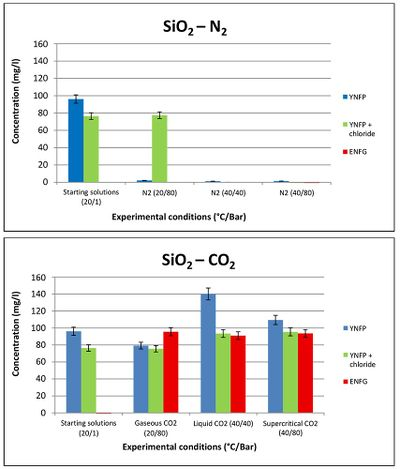
Flow experiments
The aim of these experiments was to investigate changes in flow properties of NRVB cement in response to ingress of gaseous, supercritical and dissolved CO2. This was achieved by confining the cement test sample, forcing an advective flow through the sample, and carefully monitoring inlet and outlet flow rates and pressures. These results were then used to calculate flow properties. Details of this work are described in Purser et al. (2013a, b[5]).
The same NRVB cement was used as in the static batch experiments, but this time it was sub-cored to produce samples of 49 mm diameter x 49 mm long. The small cylindrical samples were sandwiched between sintered filters (to facilitate fluid distribution) and stainless steel end caps. A Teflon jacket was used to exclude the confining fluid. Volumetric flow rates into and out of the samples were controlled and monitored using a pair of ISCO-500HP, series D, syringe pumps operated from a single digital control unit linked to remotely operated LabViewTM software (Figure 9). Data collection was performed every 2 minutes with a sub sample of this data being used for analysis. The tests were performed inside an oven at 40°C. All samples were isotropically confined at 4 MPa above pore pressure. Four main tests were conducted:
- Partial carbonation using CO2 gas (NRVB-1) at 40°C and 40 bar
- Full carbonation using CO2 gas (NRVB-2) at 40°C and 40 bar
- Full carbonation using supercritical CO2 (NRVB-4) at 40°C and 80 bar
- Full carbonation using water saturated with gaseous CO2 (NRVB-5) at 40°C and 40 bar
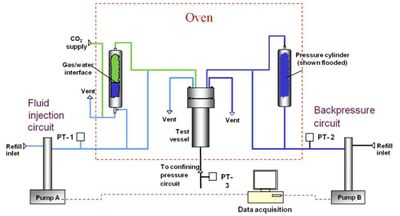
A typical test history comprised of a sequence of test stages, each designed to quantify the hydraulic and gas transport properties of the cement. A single experiment therefore, could provide information on pre-carbonation hydraulic and gas permeability, plus post carbonation permeability.
Initially, injection and backpressure pumps were filled with Ca(OH)2-saturated water to re- equilibrate the sample after initial assembly. Use of this fluid minimised the potential for portlandite leaching from the sample. Once complete, hydraulic testing commenced by increasing and decreasing the injection flow rate in a stepwise manor, doubling and halving the flow rate from 2125 µL/hr to 8500 µL/hr. N2 and CO2 injection tests then proceeded; N2 to provide baseline data for an inert gas, and CO2 to carbonate the sample. Where appropriate, a second N2 gas test was undertaken after sample carbonation.
NRVB 1: Partial carbonation test with CO2 gas
The hydraulic tests showed unaltered NRVB cement to be relatively permeable (Table 2). Previous studies of NRVB flow properties used deionised water (Francis et al., 1997), and report a slightly higher permeability coefficient of around 1 x 10-16 m2. It is thought that the use of deionised water in this earlier work may have caused some dissolution of phases within the NRVB. As a consequence, this may have resulted in artificially high porosity and permeability in the samples, and this may help explain the differences between our results and those of Francis et al. (1997)[9].
| Test | Initial hydraulic permeability (m2) | Hydraulic permeability after aqueous CO2 injection (m2) | N2 gas permeability (m2) | CO2 permeability (m2) |
| NRVB-1 | 4.3 x 10-17 | - | N/A | N/A |
| NRVB-2 before N2 | 4.1 x 10-17 | - | - | - |
| NRVB-2 after N2 | 4.2 x 10-17 | - | 2.20 x 10-19 | - |
| NRVB-2 after CO2 | - | - | 1.13 x 10-19 | 1.00 x 10-19 |
| NRVB-4 | 4.0 x 10-17 | - | - | 1.94 x 10-19 |
| NRVB-5 | 4.7 x 10-17 | 4.28 x 10-20 | - | - |
On addition of CO2 gas, injection pressure increased, indicating permeability reduction. For this first test, only a limited amount of CO2 was injected in order to investigate the carbonation front within the sample. As a consequence, steady-state flow conditions were not reached during the experiment, preventing calculation of gas permeability. An assessment was made of the amount of carbonation using an acid digestion method, with 19.5g of CO2 found to have reacted with 158.2g of NRVB cement. This is comparable with the measured amount of CO2 injected using the high precision syringe pumps.
The partially-reacted cement core displayed an obvious wedge-shaped reaction front (associated with a marked colour change) that had propagated half way along the length of the core (Figure 10), and was investigated in detail. Small-scale variation in permeability along the sample length was determined using a N2 micro-permeameter. These values are significantly higher than those for saturated NRVB quoted in Table 1 as these measurements were performed after the core had been subject to vacuum desiccation. However, the data provide an indication of the relative changes in permeability across the length of the sample. A reduction in permeability was observed within a narrow zone at the leading edge of the visible alteration front. This could account for the higher pressures generated during the CO2 injection stage of later experiments. Dissolution of CSH phases and portlandite and leaching of calcium, are observed in a very narrow region in front of the leading edge of the carbonation. This is associated with enhanced microporosity in the same region. The calcium appears to have migrated towards the carbonation front where it is concentrated in a fine meshwork of carbonate precipitation (possibly representing filled microfractures). The carbonated zone was very similar to that found in the static (diffusion-controlled) experiments comprised a 3-dimensional ‘chicken wire’ meshwork of calcite-mineralised microfractures within a nanoporous matrix of amorphous silica and fine grained patchy replacive calcite, with disseminated remnants of brownmillerite from the original cement slag. Entrained air bubbles in the cement were also partially filled by vaterite.
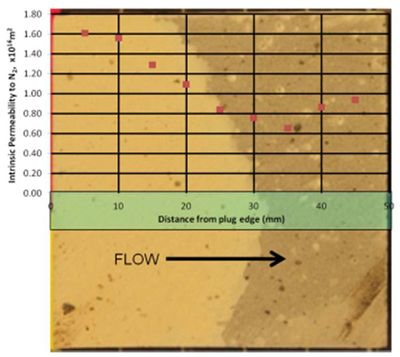
NRVB-2: Full carbonation test with CO2 gas
The hydraulic permeability data were found to be consistent with that of NRVB-1 (Table 2). Conductivity and permeability remained unaltered after the gas injection test with N2, confirming its non-reactivity with NRVB. Maximum test pressures were significantly higher during CO2 injection compared to those observed during N2 injection. A marked breakthrough was signified by an increase in outflow after 22 days, and this continued until steady state conditions were achieved. Major gas breakthrough lagged behind the pressure peak, probably reflecting the complexity of the reaction fronts. Pre- and post-carbonation gas tests (using N2) clearly show a change in permeability leading to increased gas pressures observed (Table 2).
NRVB-4: Full carbonation test with supercritical CO2
The initial hydraulic permeability data were again found to be consistent with that of NRVB-1 (Table 2). Permeability data post-carbonation for supercritical CO2 show a small reduction in permeability that is broadly similar to that for gaseous CO2 (test NRVB-2).
NRVB-5: Full carbonation test with dissolved gaseous CO2
This test was different to the other flow tests in that CO2 was added to the cement core in solution. The dissolved CO2 was prepared at pressure by reacting cement-equilibrated water with an excess of high pressure CO2, and then filtering out the extensive CaCO3 precipitate that had formed. As the CO2 was only dissolved, it was effectively added to the cement at a much lower concentration compared to the tests involving free phase gaseous and supercritical CO2. It was immediately apparent that pressures increased upon carbonation (at a constant flow rate), and that flow paths within the cement blocked up rapidly. This resulted in an approximate 3 orders of magnitude decrease in hydraulic permeability (Table 2). Dissolved CO2 therefore appears to be very efficient in reducing cement permeability. That said, this probably requires an excess of cement to be present, as prolonged exposure to a flow of acidified CO2-rich water to carbonated cement will start to dissolve the initially-precipitated carbonate phases.
Mineralogical changes
Carbonation of NRVB cement samples during the flow tests resulted in similar mineralogical changes to the static batch experiments, plus the formation of reaction fronts that travelled through the samples. Portlandite and CSH phases were destroyed, and CaCO3, silica, iron oxides/hydroxides and aluminium oxides were formed. This process is associated with localised porosity increases, which are then variably filled with secondary CaCO3. As the reaction front travelled through the sample, a tight zone of significantly reduced permeability was created. This has the ability to ‘armour’ some regions of the cement, leading to isolated islands of unreacted NRVB and so reducing its total buffering capacity. Overall bulk gas permeability is reduced on carbonation. While this behaviour may not adversely affect the transport behaviour of NRVB, further work is required to fully understand the complex coupling between fluid flow, permeability and carbonation.
Modelling advecting CO2-cement reaction
The PRECIP reaction-transport code (Noy, 1998) was used to produce an initial numerical representation of the cement carbonation experiments. This 1D code couples fluid transport to chemical reaction, and takes account of both changing porosity/permeability and mineral dissolution/precipitation rates. The code considers only a single phase fluid, and is thus a closer representation of dissolved CO2 flow experiments (experiment NRVB-5 described above). Whilst it cannot represent the injection of high pressure gas into an initially water saturated sample, its use may help understand some of the factors that control the system in the gaseous and supercritical CO2 flow experiments. Details of this work are described in Purser et al. (2013)[5]. A simplified cement composition was used, which was represented as a mix of tobermorite, calcite and portlandite, with a porosity of 52%. The pore fluid in the cement was assumed to be initially at equilibrium with this mineral assemblage. The simulation involved fluid injected into one face of the core sample, and that fluid comprised pure water equilibrated with calcite and CO2 at 4 MPa. The base case calculation assumed a large total reactive surface area (106 m2/m3) and relatively large reaction rate constants. The surface areas of the initial components within the cement were approximately in proportion to their volumes. The simulated fluid injection rate was 3 x 10-7 m3 m-2 s-1 (2 ml hr-1 for a 49 mm diameter core), which generated a porewater velocity of 5.8 x 10-7 ms-1. For a 49 mm long core this represented an injection rate of approximately 1 pore volume per day. This combination of injection and reaction rates created a short reaction zone, about 9 mm long, that progressed stepwise along the cement core. The prediction of a reaction zone is noteworthy, as it mirrors what was seen in the experimental reaction products (albeit that they were of slightly different thickness). The use of a code employing purely equilibrium chemistry would have resulted in a very sharp reaction front and no prediction of a reaction zone. The model predicted the complete transformation of tobermorite to aragonite and silica (represented by chalcedony in the model), followed by slower transformation of silica to quartz, and of aragonite to calcite. Additionally, there was gradual dissolution of portlandite adding to the generation of aragonite. A small net reduction in porosity was predicted, except near the inlet end of the core where the aragonite started to re-dissolve. The pH of the outlet fluid remained high until the reaction zone reached the end of the core.
The initial calculation was repeated with the dissolution rate of tobermorite reduced by a factor of 2.5, as were the precipitation rates for chalcedony and aragonite. The effect of this change was to increase the length of the reaction zone to about 20 mm. This demonstrates the sensitivity of the size of the reaction zone to mineral reaction rates. Shown in Figure 11 are plots of changing pH and porosity over time for this simulation, and of mineral abundance and Ca2+/HCO3- concentrations after 100 hours of simulated time. It should be noted that the pH plots for 50 and 150 hours in Figure 11 are overlain by the plots for 100 and 200 hours respectively as a result of the stepwise progress of the reaction zone.
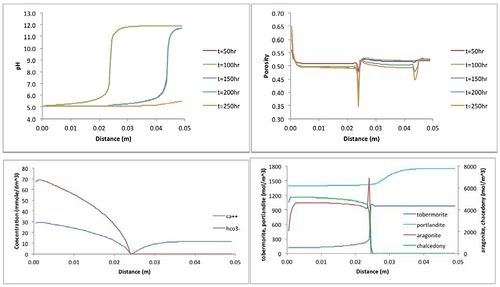
Noticeable in both base and reduced rate models are the spikes in aragonite precipitation at the end of each reaction zone step with corresponding reductions in porosity (Figure 11). The aragonite spike occurs just at the end of the tobermorite dissolution zone. The Ca2+ concentration drops to near zero at this point, but then rises again due to the dissolution of portlandite. The predicted gradient in Ca2+ concentration drives diffusion of calcium back against the porewater flow providing material for the excess aragonite precipitation at discrete intervals. Back-diffusion of Ca2+ concurs with conclusions based upon observations of the reaction front from experimental materials and previous studies (Rochelle et al., 2014[2]). However, the narrow zones of carbonate precipitation are on a cm-scale in the model, but at sub-mm scale in the experimental samples. Adjusting parameters in the model could probably produce a closer match to that observed in the experiments, though this would require more refined, much finer gridded models to better represent the complex interplay between diffusion, mineral reaction rates, mineral saturation and fluid flow rates.
References
- ↑ ROCHELLE, C A, and PURSER, G. (2010). Towards D3.6: results of the tests on concrete (part 1). Laboratory experiments at the BGS. FORGE project technical report. 16pp.
- ↑ 2.0 2.1 2.2 ROCHELLE, C A, PURSER, G, MILODOWSKI, A E, and WAGNER, D. (2014). Results of carbonation tests on cement: Laboratory experiments at the BGS. British Geological Survey Report.
- ↑ CAREY, J W, WIGAND, M, CHIPERA, S J, WOLDEGABRIEL, G, PAWAR, R, LICHTNER, P C, WEHNER, S C, RAINES, M A, and GUTHRIE, J. 2007. Analysis and performance of oil well cement with 30 years of CO2 exposure from the SACROC Unit, West Texas, USA. International Journal of Greenhouse Gas Control, 1, 75–85.
- ↑ 4.0 4.1 REARDON, E J, JAMES, B R, and ABOUCHAR, J. (1989). High pressure carbonation of cementitious grout. Cement and Concrete Research, 19, 385–399.
- ↑ 5.0 5.1 5.2 5.3 PURSER, G, MILODOWSKI, A E, HARRINGTON, J F, ROCHELLE, C A, BUTCHER, A, and Wagner, D. (2013). Modification to the flow properties of repository cement as a result of carbonation. Procedia Earth and Planetary Science, 7, 701–704.
- ↑ ROCHELLE, C A, PEARCE, J M, BATEMAN, K, BIRCHALL, D J, CHARLTON, B D, REEDER, S, SHAW, R A, TAYLOR, H, and TURNER, G. (2004). Geochemical interactions between supercritical CO2 and borehole cements used at the Weyburn oilfield. British Geological Survey Commissioned Report, CR/04/009, 22 p.
- ↑ ROCHELLE, C A, BATEMAN, K., MILODOWSKI, A E, KEMP, S J, and BIRCHALL, D. (2006). Geochemical interactions between CO2and seals above the Utsira Formation: An experimental study. British Geological Survey Commissioned Report, CR/06/069. 86 pp.
- ↑ ROCHELLE, C A, MILODOWSKI, A E, SHI, J-Q, MUNOZ-MENDEZ, G, JACQUEMET, N, and LECOLIER, E. (2007). A review of the potential impact of CO2 on the integrity of well infrastructure for underground CO2 storage. British Geological Survey Commissioned Report, CR/07/204, 83p.
- ↑ FRANCIS, A J, CATHER, R, and CROSSLAND, I G. (1997). Development of the Nirex reference vault backfill; report on current status in 1994. Nirex Science Report S/97/014, United Kingdon Nirex Limited, 57p.